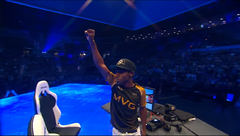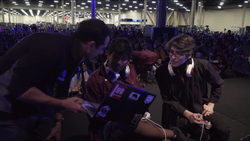Super Smash Bros. 4 in competitive play
Super Smash Bros. 4's competitive scene began before either version was publicly released at the Super Smash Bros. Invitational on June 10, 2014, hosted by Nintendo of America at E3 2014, where they presented a demo of Super Smash Bros. for Wii U. ZeRo had emerged victorious, beginning his infamous winning streak of many Smash 4 majors to come.
Smash 4 is the first Smash game to have balance patches via online download, which had a significant impact on tournament play. These updates forcefully shifted almost every characters' metagame (by varying degrees) multiple times through 2014 into 2016.
2014: Release and Super Smash Bros. for Nintendo 3DS[edit]
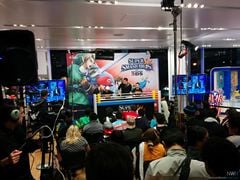
Super Smash Bros. for Nintendo 3DS had a small amount of time being used in competitive play from September 12th until around the end of December. The vast majority of the competitive scene utilised the Wii U game, as it allows for superior viewing quality and native GameCube controller support. Despite the Wii U version being released, the 3DS version of the game is still actively played by causal players and online play but not played competitively.
Since the 3DS game started with version 1.0.0, it initially had a plethora of bugs, (primarily carried over from Super Smash Bros. Brawl), some of which was either an enhancement or was a deterrence to the competitive scene. Gameplay imbalance was also far more prominent. For instance, DACUS was still in from Brawl, and was discovered through using hacks to make the GameCube controller usable. However, it was completely removed in the Wii U version and version 1.0.4 in the 3DS version.
The Umebura tournament series was among the only national level tournaments ever held for Smash 3DS.
2015: Beginnings and ZeRo's Dominance[edit]
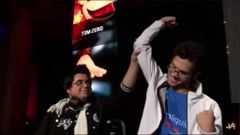
2015 marks the first year of the Super Smash Bros. for Wii U's competitive timeline. This Smash game had a rather unique start compared to previous ones, considering the fact that the 3DS version was essentially the same game. Players were able to "hit the ground running" going into the new year. The 3DS version saw a dramatically reduced tournament presence, as its Wii U counterpart shares the same gameplay while benefiting from more control options and clear, high-definition graphics. Thus, every major from here was played on the Wii U version.
Infamously, Diddy Kong's powerful neutral game and throw combos, most notably the "Hoo-Hah" (down/up throw to up air), dominated competitive play, and Diddy dittos were common, much to the disapproval of spectators. However, Diddy would get nerfed in coming patches. The many balance patches and five new DLC characters all released throughout the year resulted in an extremely unstable metagame. There was also debate over the legality of custom moves, which were allowed at the biggest tournament to date, EVO 2015, but banned in most tournaments soon afterwards.
At Smash Factor 4, the largest Mexican Smash 4 tournament at the time, young competitor Leo caused a massive upset by defeating Brawl veteran Mr. R, one of Europe's best players, by using Meta Knight, improving perception of the character and setting up for a dominant Smash career.
These various changes did not stop ZeRo from achieving a record streak of 56 tournament wins, taking majors such as Apex 2015, EVO 2015, and The Big House 5, becoming the undisputed best player in the game at the time. The streak ended at MLG World Finals 2015, where Nairo defeated him in Grand Finals to become the only player to eliminate ZeRo in a Smash 4 tournament in 2015.
2016: The Meta Changes and ZeRo's Temporary Hiatus[edit]
This year saw the release of the last two DLC characters, Corrin and Bayonetta. Bayonetta was seen as a highly controversial character, due to her powerful combo game, allowing her to zero-death most foes, and Witch Time giving her one of the strongest punish games in Smash 4. Bayonetta was notably banned from tournament play in Spain, Russia, and certain areas in the United States. However, significant nerfs, most notably in May's patch 1.1.6, brought her on more even ground with other characters, and the bans were lifted. The lack of any other patches for the rest of the year finally gave the metagame time to develop without interruptions.
With ZeRo taking a brief absence from the competitive scene due to medical issues and Nairo unable to maintain the consistency he had the previous year, the meta gave way for players ranked below both of them on the Panda Global Rankings to rise. Upon ZeRo's return to the scene in May, he was no longer the dominant force he was previously, with a wider array of players defeating him compared to before the hiatus. Ally notably holds a positive record over him since the onset of patch 1.1.6 as a result, defeating him at events like Get On My Level 2016, Smash 'N' Splash 2 and Super Smash Con 2016. The 2016 summer season was defined as the rise of Mario in the metagame as ANTi and Ally won CEO 2016 and EVO 2016 respectively using mostly Mario. September marked the rise of Apex 2013 champion Salem in the game as he double-eliminated ZeRo at Collision XIV. Despite the losses he took since his return, ZeRo slowly regained his dominance over the game, albeit not as strong as before, with him winning Shine 2016, 2GGT: Abadango Saga, The Big House 6 and UGC Smash Open.
MKLeo, who was well known for defeating Mr. R at Smash Factor 4 over a year prior, secured a US visa in October 2016, allowing him to enter tournaments in the United States. This led to him winning his first ever US major by the end of the year: 2GGT: ZeRo Saga, defeating a wide array of players such as ANTi, Ally, ZeRo, VoiD and Larry Lurr using Marth, which led to his rise in the metagame.
2017: The 2GG Championship[edit]
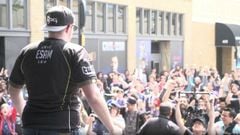
The year began with 2GGC: GENESIS Saga, the first qualifier of the 2GG Championship Series, a circuit of tournaments announced at 2GGT: ZeRo Saga. ZeRo, who had established his return to dominance at the end of 2016, won the tournament. The first premier of the year, GENESIS 4, was won by MKLeo, being his second major win after ZeRo Saga. The first half of the year would be described as the introduction of more Japanese players to the United States, starting with Frostbite 2017, being the US debut of players such as Shuton, T, Some and Tsu-, who notably defeated ZeRo at the tournament (going on to place 2nd to him). The third qualifier of the 2GG Championship Series circuit, 2GGC: Civil War, became one of the largest tournament in the game's history, with 47 of the 50 players on the Panda Global Rankings v2 attending. Despite the numerous amounts of upsets, the tournament was ultimately won by Dabuz, then ranked #4 on the PGRv2.
The early months of 2017 marked the rise of players such as Locus and CaptainZack. Locus, having placed 9th at ZeRo Saga in 2016 (defeating players such as Mr. R and Tweek), ended up finishing 7th at Civil War, notably defeating Nairo. CaptainZack placed 4th at both GENESIS 4 and Civil War. Along with Salem's relative fall from grace as he was unable to make top 8 at a notable tournament, CaptainZack was considered the best Bayonetta at the time. At around the same time, Trela's retirement from the scene combined with Locus's Top 8 finish at Civil War caused Locus to be considered the best active Ryu in the world.
The first premier tournament after Civil War was 2GGC: Nairo Saga, which was won by ZeRo, though Salem rose back to being the best Bayonetta player as CaptainZack's recent placings became inconsistent while Salem made top 8 at four major tournaments, placing 2nd at Nairo Saga, 7th at CEO 2017 and 1st at both EVO 2017 (notably defeating ZeRo) and DreamHack Atlanta 2017. Patch 1.1.7 was released the week after EVO ended, though it did not change any characters.
The second half of the year was characterized by Bayonetta's rise in the meta, as Bayonetta's results improved with players such as Salem, Mistake and CaptainZack placing top 8 at several major tournaments. Most notably, Salem's tournament victories such as EVO 2017, DreamHack Atlanta 2017 and 2GGC: Fire Emblem Saga made him a contender for the number one spot, however ZeRo was ultimately able to hold him off by winning 2GGC: SCR Saga, Shine 2017 and having a 6-4 record over him during the PGRv4 season. The 2GG Championship was held in December and was won by MkLeo with ZeRo placing 2nd, Salem 3rd.
2018: The Final Year and A Vacant Throne[edit]
With ZeRo's retirement from the scene in January, the #1 spot on the Panda Global Rankings was up for grabs, with players such as MkLeo, Nairo, Dabuz and Tweek setting their sights on taking ZeRo's throne. MkLeo led the charge by taking GENESIS 5, followed by Dabuz taking Frostbite 2018. Nairo would challenge MkLeo by taking Niconico Tokaigi 2018 and Smash Masters League: Battle for Vegas over him and winning Collision XV, though MkLeo would defeat him at SwitchFest and Get On My Level 2018. In the latter half of the season, Tweek would rise by winning MomoCon 2018 and 2GG: Hyrule Saga. Smash 'N' Splash 4 was won by VoiD, marking the first time Sheik won a major tournament since 2016. MkLeo and Tweek would face off at the final tournament of the PGRv5 season, CEO 2018, where MkLeo won, solidifying himself as the new #1 player in the world.
The first half of the year also saw an increase in representation for certain low tier characters. Most notably, Glutonny, a Wario main who was considered the second best player in Europe, would enter a few American tournaments, achieving high placements such as 9th at Midwest Mayhem 11 and 13th at Get On My Level 2018 while defeating players such as Darkshad and Fatality. Captain L also surprised many people by defeating top players, including Larry Lurr, with Jigglypuff, a character considered the worst in the game, while ZAKI, a Japanese King Dedede player, notably defeated MkLeo at 2GG: Hyrule Saga placing 17th.
With Super Smash Bros. Ultimate being teased in March and a 2018 release date revealed at E3 2018, interest in Smash 4 waned as most of the community looked to move on to that game. Had Ultimate released in time for EVO 2018, Smash 4 would have been dropped in favor of the newer game.[1] The Smash 4 event at EVO had lower attendance and viewership than the previous year, and a controversial incident occurred during Grand Finals: in a Bayonetta ditto match, Lima and CaptainZack did not seem to take the set seriously, and in one match stalled charging Bullet Climax for two minutes straight, leading tournament organizer Bear to go on stage to issue them both a yellow card in order to get them to play. Top players such as ZeRo believed this incident tarnished the image of the competitive Smash community. Regardless, Lima went on to win the tournament, his first victory at a supermajor.
Despite a new installment approaching and decreasing attendance, Smash 4 tournaments were held up until the release of Ultimate. MkLeo won the largest Smash tournament of the year at Super Smash Con 2018, beating the defending 2016-2017 champion Nairo in Winners Semifinals and Samsora in both Winners Finals and Grand Finals. Shine 2018 had Bayonetta players Salem, Mistake, and Tweek take the top 3 spots, further solidifying the character's dominance in the game's final years. At The Big House 8, Cosmos became the first and only Corrin player to win a national tournament. Eim won Umebura Smash 4 Final, the last national tournament before the release of Ultimate a week later.
PGR 100 ranked the best 100 players of all time for Smash 4, starting with Apex 2015 and ending with DreamHack Atlanta 2018. Although being retired for the last year, ZeRo was expectedly ranked the best player of all time, due to his dominance throughout the game's lifespan. The following rankings were Nairo at 2nd, MkLeo at 3rd, Dabuz at 4th, Ally at 5th, Salem at 6th, and Tweek at 7th, with all of them having been ranked in the Top 3 on at least one of the previous PGRs. Larry Lurr was ranked 8th, KEN was ranked 9th, and Mr.R was ranked 10th.
Post-Ultimate Release[edit]
Tournament activity of the game declined sharply following the release of its successor, Super Smash Bros. Ultimate. Although a few major tournaments such as Albion 4, Super Smash Con 2019, and CEO Dreamland 2020 would host Smash 4 events, they would either have low entrant counts or a significant amount of disqualifications.
Effect on the Melee and Brawl communities[edit]
Smash 4 has had little impact on Melee's tournament scene, as it is not uncommon for both games to be featured at tournaments simultaneously. Most already established Melee players have chosen to stay with the Melee community over Smash 4 due to several factors; they include the physics of Smash 4 being more similar to the controversial Brawl game engine, their main being more tournament viable in Melee than in SSB4 (such as with Falco and formerly Marth), or Smash 4 having a lower reliance on technical skill. Overall, both games attract large numbers of players and spectators.
Brawl's competitive scene has largely tapered off and moved onto Smash 4 since it was released. Almost all of its high-level players primarily played it because it was simply the latest installment in the series after Melee and was, therefore, their personal preference.
While the Smash 4 engine was viewed as more tournament-friendly than that of Brawl ever since its earliest days, character balance has helped greatly in the game's perception relative to others. In contrast to the infamously unbalanced Brawl, SSB4 balance patches have allowed unbalanced character matchups and attributes to be corrected throughout the game's lifetime, resulting in a very large range of viable characters (including historically poor characters such as Bowser and Mewtwo), top-tier characters that are relatively easier to defeat, and bottom-tier characters that can hold up better against the higher tiers (to the point that the "Bottom" tier ranking was completely abolished in the third tier list). Some SSB4 supporters cite this as an advantage over even Melee, due to the fact that its top-tier characters are more dominating and ubiquitous than those of SSB4 (particularly its single best character in Fox), resulting in near-universal use of the top tiers and fewer appearances and results from lower-tier characters.
Criticisms of competitive Smash 4[edit]
Although Smash 4 has been more successful competitively than Brawl, it has not come without its own criticisms. A number of former and current Brawl players have stated their preference for the older title, believing Brawl to have had greater competitive depth. For example, edgehogging was removed from Smash 4 in favor of ledge trumping, significantly limiting the power of edgeguarding, which has been a core aspect of previous Smash games. In addition, in Brawl, many characters could perform techniques such as DACUS and glide tossing, which created enhanced movement options; these techniques were largely removed in Smash 4. In fact, several post-Ultimate tournaments (such as Return to Subspace 2, Come to Papa 3, Get On My Level 2019, GENESIS X and Return to Subspace 3), have featured Brawl but not Smash 4.
See also[edit]
- Tournament rulesets (SSB4)
- Super Smash Bros. 64 in competitive play
- Super Smash Bros. Melee in competitive play
- Super Smash Bros. Brawl in competitive play
- Super Smash Bros. Ultimate in competitive play
